the Creative Commons Attribution 4.0 License.
the Creative Commons Attribution 4.0 License.
In-flight calibration results of the TROPOMI payload on board the Sentinel-5 Precursor satellite
Antje Ludewig
Quintus Kleipool
Rolf Bartstra
Robin Landzaat
Jonatan Leloux
Erwin Loots
Peter Meijering
Emiel van der Plas
Nico Rozemeijer
Frank Vonk
Pepijn Veefkind
After the launch of the Sentinel-5 Precursor satellite on 13 October 2017, its single payload, the TROPOspheric Monitoring Instrument (TROPOMI), was commissioned for 6 months. In this time the instrument was tested and calibrated extensively. During this phase the geolocation calibration was validated using a dedicated measurement zoom mode. With the help of spacecraft manoeuvres the solar angle dependence of the irradiance radiometry was calibrated for both internal diffusers. This improved the results that were obtained on the ground significantly. Furthermore the orbital and long-term stability was tested for electronic gains, offsets, non-linearity, the dark current and the output of the internal light sources. The CCD output gain of the UV, UVIS and NIR detectors shows drifts over time which can be corrected in the Level 1b (L1b) processor. In-flight measurements also revealed inconsistencies in the radiometric calibration and degradation of the UV spectrometer. Degradation was also detected for the internal solar diffusers. Since the start of the nominal operations (E2) phase in orbit 2818 on 30 April 2018, regularly scheduled calibration measurements on the eclipse side of the orbit are used for monitoring and updates to calibration key data. This article reports on the main results of the commissioning phase, the in-flight calibration and the instrument's stability since launch. Insights from commissioning and in-flight monitoring have led to updates to the L1b processor and its calibration key data. The updated processor is planned to be used for nominal processing from late 2020 on.
- Article
(10013 KB) - Full-text XML
- BibTeX
- EndNote
The Sentinel-5 Precursor (S5P) mission is part of the Copernicus Earth observation programme by the European Union. It is the first atmospheric observing mission within this programme (Ingmann et al., 2012). With its launch on 13 October 2017 the S5P mission can avoid large gaps in the availability of global atmospheric products between the future missions Sentinel-4 and Sentinel-5 and earlier and ongoing missions such as SCIAMACHY (Bovensmann et al., 1999), GOME-2 (Munro et al., 2016) and OMI (Levelt et al., 2006). The S5P satellite flies in a low Earth orbit (824 km) and is Sun-synchronous with an Equator crossing time of 13:30 local solar time. The TROPOspheric Monitoring Instrument (TROPOMI) is the only payload on S5P. It was jointly developed by the Netherlands and ESA. With its push-broom imaging system with spatial sampling down to about 5.5 km×3.5 km, a daily global coverage is achieved for trace gases and aerosols important for air quality, climate forcing and the ozone layer. TROPOMI contains four spectrometers with spectral bands in the ultraviolet (UV), the visible (UVIS), the near-infrared (NIR) and the shortwave infrared (SWIR) wavelengths (Veefkind et al., 2012). The main characteristics of TROPOMI are listed in Table 1, and a functional schematic is shown in Fig. 1.
Table 1Main products and characteristics of the four TROPOMI spectrometers and the definition of the spectral bands with identifiers 1–8. The listed values are based on on-ground calibration measurements (see Kleipool et al., 2018) and are valid at the detector centre. The performance range is the range over which the requirements are validated; the full range is larger. The nominal spatial sampling distance (SSD) is given at nadir for the updated operations scenario.
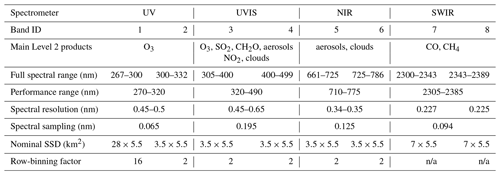
Note that n/a is not applicable.
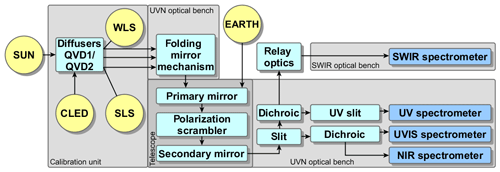
Figure 1Functional diagram of the TROPOMI instrument. When the folding mirror is open, light from Earth enters the instrument's telescope. At the instrument slit, light for the UV and SWIR spectrometers is reflected, while it is transmitted for the UVIS and NIR spectrometers. Dichroic mirrors split the light further to the respective spectrometers. The SWIR spectrometer is housed in a separate optical bench connected by relay optics. When the folding mirror is closed, light can enter from the calibration unit. Light from the internal white-light source (WLS) and the spectral-line source (SLS) is reflected off the sides of the diffusers, while light from the common LED (CLED) or the Sun passes through either of the two quasi volume diffusers (QVD1 and QVD2).
This wavelength range allows for observation of key atmospheric constituents such as ozone (O3), nitrogen dioxide (NO2), carbon monoxide (CO), sulfur dioxide (SO2), methane (CH4), formaldehyde (CH2O) aerosols and clouds. The instrument measures the radiance on the day side of each orbit and once a day the irradiance via a dedicated solar port as shown in Fig. 1. Sunlight passes through one of the two internal quasi volume diffusers (QVD1 and QVD2) and is coupled via the folding mirror into the telescope of the instrument. A detailed instrument description can be found in KNMI (2017) and Kleipool et al. (2018).
The S5P mission flies in constellation with the NOAA NASA Suomi NPP (National Polar-orbiting Partnership) satellite. The difference in overpass time is 3–5 min, so high-resolution cloud information and vertically resolved stratospheric ozone profiles from the Suomi NPP instruments VIIRS (Visible Infrared Imaging Radiometer Suite) and OMPS (Ozone Mapping and Profiler Suite) can act as supplementary input for TROPOMI data processing. Prior to launch the TROPOMI instrument was tested and calibrated as reported in Kleipool et al. (2018). Not all calibration data could be derived with the desired accuracy and had to be recovered during the E1 phase. For the solar angle dependence of the irradiance radiometry, this could be carried out during the commissioning phase.
During the first 6 months of the mission, the instrument was commissioned and dedicated measurements were scheduled to validate the geolocation; calibrate the angular dependency of the irradiance radiometry for both internal diffusers; and calibrate detector and electronic effects such as gain, offsets and non-linearity. All instrument settings for all internal and external sources were checked and optimized for an optimal signal-to-noise ratio, while leaving a margin for changes in signal. The timing and definition of the measurement sequences of the different orbit types were adapted to match the detected darkness of the eclipse. The changes to the instrument settings and on-board procedures were extensively tested and burnt into the instrument's electrically erasable programmable read-only memory (EEPROM) before the start of the nominal operations (E2) phase. At regular intervals dedicated monitoring measurements were performed to assess the instrument's long-term stability and its stability over an orbit. Also radiance and irradiance data were measured to optimize the nominal settings and allow for testing of the S5P Payload Data Ground Segment (PDGS) and Level 2 (L2) processing. In two different zoom modes high-spatial-sampling radiance data were also measured for NO2, cloud, CH4 and CO retrievals.
Since orbit 2818 on 30 April 2018 the mission has been in its nominal operations (E2) phase with a fully repetitive scenario and systematic processing and archiving of data products by the PDGS. The L2 products are disseminated to both operational users (e.g. Copernicus services, national numerical weather prediction (NWP) centres, value-adding industry) and the scientific user community. The repetitive scenario includes daily solar measurements and calibration measurements with internal light sources at the eclipse side of each orbit. In the following, the main results from the commissioning phase and in-flight monitoring will be presented.
At the very beginning of the mission the instrument's prime contractor, Airbus Defence and Space Netherlands, could confirm that the thermal controls are within their predicted values and that the temperature setpoints can remain the same as those used during on-ground calibration; see Kleipool et al. (2018). According to the prediction there is a sufficient residual margin on all active thermal control channels to ensure temperature stability of the complete instrument over the entire mission lifetime. All measurements described in this article were performed at the nominal temperatures with active thermal stabilization. Monitoring shows that the detector temperatures are stable within 10–30 mK; the lower values are for the SWIR and UV detectors. The NIR and UVIS detectors are within the larger range. The instrument has two optical bench modules (OBMs): the SWIR-specific OBM (SWIR OBM) and the OBM including the UV, UVIS and NIR (UVN) spectrometers and the common telescope (UVN OBM). Both the SWIR and the UVN OBM are stable within 60 mK. All values are well within their specifications. During nominal instrument operation, the only exceptions to the thermal stability occur during and after orbital manoeuvres when the radiant cooler points in a suboptimal direction. The UVN detectors and OBM recover their stability within one to two orbits. For the SWIR grating, the recovery takes the longest time: for out-of-plane manoeuvres up to 35 orbits have been observed. This leads to an estimated spectral shift of 0.12±0.01 nm K−1. With version 2 of the Level 1b (L1b) processor, measurements taken under non-nominal thermal conditions will be flagged.
The folding mirror mechanism (FMM) closes the Earth port of the instrument and relays light from the calibration unit (CU) to the instrument's telescope as indicated in Fig. 1. When the FMM is closed the entire instrument can be closed off from external light for certain positions of the diffuser mechanism (DIFM). The closed position is however not entirely light tight as in-flight tests showed. For the UVN detectors, signals up to 100 times the dark current could be observed when the instrument is in the closed position. For the SWIR module no light leaks were detected; however the SWIR module is sensitive to hot spots such as gas flares on the eclipse side (see van Kempen et al., 2019). The nominal operations baseline was therefore adapted such that all calibration measurements only start once the spacecraft is in full eclipse, and the radiance background is only measured with a closed FMM, as described in Sect. 14.
The TROPOMI instrument contains several internal light sources. LED strings are placed close to each of the detectors (DLEDs) and in the calibration unit (see Fig. 1) are a white-light source (WLS), an LED in the visible wavelength range (CLED) and a spectral-line source (SLS). The SLS consists of five temperature-tunable narrowband diode lasers in the SWIR wavelength range. During the commissioning phase, all internal sources were checked and compared to measurements performed during on-ground calibration. The differences in detector response in flight relative to on the ground are close to 1 for the DLEDs, CLED and SLS. The WLS shows the expected increase in brightness due to the microgravity environment; the signal is about 1.1–1.4 times larger in flight. During nominal operations the internal light sources are used for calibration measurements and their output signal is monitored for ageing effects. For the DLEDs and the CLED the average detector response decreases approximately linearly. For the WLS the average detector response decreases linearly for all detectors but the SWIR one. Both the CLED and WLS show variations in observed signal of ±0.5 % from measurement to measurement; for the DLEDs the variation is smaller than 0.05 %. The average decrease in measured signal per 1000 orbits is shown in Table 2. Depending on the source and its location in the instrument, the listed values can contain contributions from the degradation of the source, its specific optics, the diffusers, the folding mirror, the telescope and the spectrometers. The output of the SLS is stable as already reported in van Kempen et al. (2019).
The orbital stability of electronic gains, offsets and noise was tested with dedicated measurements during the commissioning phase. For the SWIR module, as reported in van Kempen et al. (2019), no orbital dependencies were detected for offset, dark current and noise.
For the UVN detectors the orbital dependency of the dark current could not be established since the FMM is not sufficiently light tight. The dark current measurements on the eclipse side suggest a dark current of 2 ; this is consistent with the on-ground results. Also the offsets that are derived from in-flight data show the same behaviour as on the ground. There is no significant orbital dependency of the computed gains for the programmable gain amplifier (PGA), correlated double sampling (CDS) gain and CCD output node gain ratios; however there is a temporal drift of the CCD gain ratio and the gain alignment between bands – see Sect. 6 below. The non-linearity calibration key data (CKD) obtained from in-flight data differ from the on-ground key data by no more than 1 ‰ of the signal.
The CCD output nodes of the UVN detectors convert the signal from charge to voltage. The CCD output nodes can be used with a high or a low electronic gain to optimize the signal. It has been found that the amplification can drift in time for the low-CCD-gain setting. The drift can be calculated from the relative change in the gain ratio between the high- and low-CCD-gain setting. The CCD gain ratio is derived from the image-averaged signals of unbinned DLED measurements with four different exposure times for both high and low CCD gain. Regression lines are fitted through these four data points for each gain setting. The ratio of the slopes of the regression lines for both CCD gain settings is the CCD gain ratio. The ratios are around 1.8 but are different for each band as shown in Fig. 2a. The figure shows the variation over time in the ratio of CCD gain settings, and in Fig. 2b the ratio with respect to the gain ratio measured on the ground is shown. Compared to the on-ground value the ratio deviation is always at least 0.54 % and reaches more than 1.4 % in band 2. The biggest change occurs around orbit 2765, when the instrument was switched off entirely to be able to burn the EEPROM. Before the EEPROM burn there are large variations and fewer measurement points. This is during the commissioning phase. Since the EEPROM burn the measurements are all taken according to the nominal operations baseline, i.e. radiance measurements on the day side and calibration measurements on the eclipse side of each orbit. After the EEPROM burn the gain ratio relaxes at different rates to more constant values; however during spacecraft manoeuvres around orbits 3470 and 6010, the bands 3–6 – the UVIS and NIR detectors – show dips in the gain ratio. During the E2 phase eight other spacecraft manoeuvres were performed which do not show in the gain ratio. No correlations were found between the drift in the gain ratio and changes in temperatures, voltages or other housekeeping parameters of the instrument.
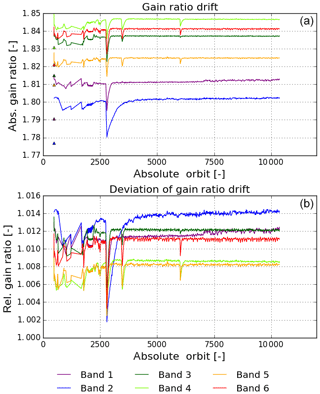
Figure 2Gain drift of the UVN CCD detector output nodes. Panel (a) shows the ratio of the high- and low-CCD-gain setting over time, and panel (b) shows this ratio over time with respect to the on-ground ratio. The different colours represent the different detector bands (see legend). The triangles in the top panel show the gain ratio as derived from on-ground measurements.
Due to the separate read-out chains for each detector half, the band signals need to be aligned in the centre of the detector as described in KNMI (2017); a drift in the CCD gain also changes this gain alignment. When the gain alignment factor for each band is calculated, the ratio of these factors follows the ratio of the low–high gain ratio drift as can be seen in Fig. 3. Figure 3b shows the drift relative to the first available in-flight measurement. The correlation between the inter-band gain ratio drift and the alignment gap becomes clear. The gain alignment for the high-CCD-gain setting changes by less than 0.05 %, while for the low-gain setting changes up to 0.5 % occur. The UVIS and NIR detectors show similar behaviour. During the nominal operations phase E2 the CCD gain ratio is computed on a daily basis from dedicated DLED measurements. The computation is automatically performed by the in-flight calibration (ICAL) processor at the payload data ground segment (PDGS) and the result is therefore available in the calibration data product. The correction of the gain drift is performed in the L1b processor with a regularly updated calibration key data (CKD) file. The signal for a specific UVN band is then corrected with the interpolated or extrapolated factor depending on the current orbit number.
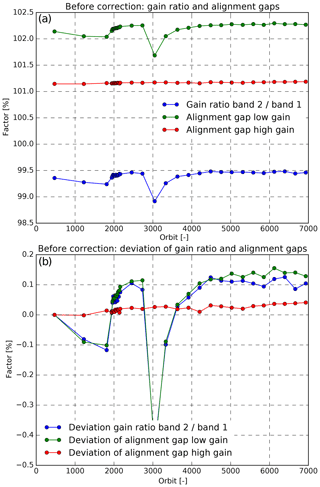
Figure 3Without CCD gain drift correction, the alignment correction factor ratio between bands 1 and 2 for low-CDD-gain (green) and high-CDD-gain (red) setting together with the relative drift of the computed gain ratios (blue). Panel (a) shows the absolute values, and panel (b) shows the values relative to the first available in-flight data. The alignment correction factor ratio for low gain follows the gain ratio drifts.
After the gain drift correction, the recomputed alignment factor is indeed more or less 1, for both the high- and the low-gain measurement as shown in Fig. 4, and does not follow the initially derived gain ratio drift (blue line). The inter-band alignment gap now stays well below 0.1 % for all orbits and all bands. The deviation from the alignment will be continually monitored. If the deviations grow in spite of the gain drift correction, a realignment can be performed by a CKD update.
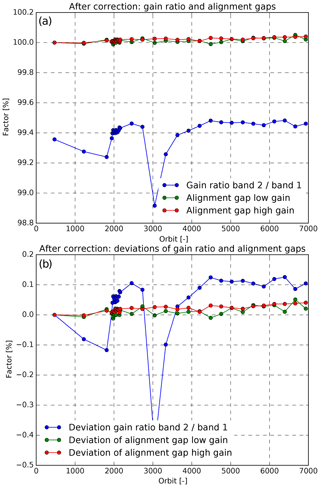
Figure 4With CCD gain drift correction, the alignment correction factor ratio between bands 1 and 2 for low-CDD-gain (green) and high-CDD-gain (red) setting together with the relative drift of the originally computed gain ratios (blue). Panel (a) shows the absolute values, and panel (b) shows the values relative to the first available in-flight data. The alignment correction factor ratio is around 1 after the gain drift correction.
The simplest solution to increasing the gain stability would be to only use the high-CCD-gain setting. This is however not possible for radiance measurements. A high-CCD-gain setting would require shorter exposure times to avoid saturation of amplifiers in the electronic read-out chain. The high optical throughput of the UVIS and NIR spectrometers already requires the shortest possible exposure times. For the UV spectrometer the high fixed gain in the analogue video chain and ozone hole conditions prevent the high CCD gain from being used. To minimize the possible impact on the values of the Earth's reflectance, it was chosen to use the same instrument settings for both radiance and irradiance measurements where possible.
For very bright radiance scenes, for example above high clouds in the tropics, the CCD pixels of bands 4–6 can saturate. This is caused by the combination of the optical throughput, which is higher than designed, and the pixel and register full-well values, which are lower than designed. For the CCD detectors, spatial binning is applied: the charge of several successive detector rows is added to the register and then read out. By adapting the binning schemes for the CCD detectors and minimizing the exposure time, the saturation issue could be partly mitigated. However, it is impossible to completely avoid saturation for bands 4–6. In the tropics typically about 0.2 %–0.5 % of the pixels are flagged for saturation in bands 4–6; other regions and bands are hardly ever affected. In the case of heavy pixel saturation, charge blooming can occur: excess charge then flows from saturated pixels into neighbouring pixels in the detector row direction (spatial direction). For TROPOMI this means that a bright, saturated scene will affect neighbouring scenes, resulting in higher signals for 1 or more spectral pixel in these neighbouring scenes. The internal light sources are not suitable for observing this effect, as they have a flat illumination pattern and charge blooming is best observed with a high contrast in the detector row (across-track) direction. Therefore reflectance data from saturated scenes were used to determine the extent of the blooming for various pixel fillings. A new dedicated L1b algorithm checks if pixel fillings exceed specific thresholds and then flags up to 24 pixels in the row direction. This new algorithm is included in version 2 of the L1b processor.
During on-ground calibration the line of sight of each TROPOMI detector pixel was calibrated with a collimated white-light source as described in Kleipool et al. (2018). As there is no comparable source available in flight, a special measurement mode was developed for in-flight validation where data are acquired for all detectors with the highest possible spatial resolution. This is carried out by setting the binning factor for the UVN detectors to 1 for all illuminated rows and reducing the co-addition time for all detectors. This zoom mode leads for the UVN spectrometers to ground pixels with a size of approximately 1.8 km×1.8 km in the along-track × across-track direction at nadir and 1.8 km×9.2 km at the edge of the swath. For the SWIR spectrometer 1.8 km×7.1 km is reached at nadir and 1.8 km×37.5 km at the edge of the swath. However, not all detector pixels can be read out with this high resolution, as both internal data rate limits and the data downlink limit would be reached. To circumvent this, only a small range of columns at the detector edges is read out for the UVN detectors, so only a narrow spectral range is available per UVN band. The SWIR module has a complementary metal–oxide–semiconductor (CMOS) detector, and pixel selection can only be carried out per band, so it was chosen to read out only band 7, the lower wavelength half of the SWIR detector.
For the analysis a number of latitude–longitude windows are selected with a straight coastline with a large radiance contrast in either the across-track or the along-track direction. Within these windows the 4 consecutive ground pixels with the largest radiance difference are found in the direction orthogonal to the coastline. A third-degree polynomial is fitted through these four points, and its inflection point is calculated. If the inflection point lies between the second and third pixel, it is considered to be a measured coastline point by TROPOMI. Scenes where cloud coverage disturbs the coastline determination are discarded by visual inspection. Two reference coastline datasets published by NOAA are used to determine the difference with the polyline formed by the valid inflection points: the (preliminary) ca. 50 m accuracy high-water-line Prototype Global Shoreline Data (PGSD; NOAA, 2016a) and the ca. 500 m accuracy average-water-line World Vector Shoreline (WVS; NOAA, 2016b) datasets released within the Global Self-consistent, Hierarchical, High-resolution Geography Database (GSHHG). As can be seen on the right in Fig. 5 the differences between the high- and the average-water reference are quite large. Furthermore it can be seen that the references used are based on outdated satellite imagery: the artificial island group Durrat Al Bahrain (construction start 2004) in the south-east is only partially visible in the PGSD reference. The accuracy of the available coastline data in combination with the deviating tidal level during the TROPOMI overpass is a source of errors in this analysis. Other possible error sources are shallow water with increased radiance levels, river estuaries, lagoons and clouds missed by the visual inspection. The analysis was performed for different scenes distributed all over Earth for bands 4–7; for bands 1–3 the contrast was found to be too small. The best land–sea contrast is observed for band 6.

Figure 5The left plot shows a Google Maps satellite view of the island country of Bahrain. The smaller island Um Al Naasan to the west has a size of approximately 4 km×5.5 km. The colour mesh plot on the right-hand side is made using TROPOMI geolocation zoom radiance data of band 6 for orbit 1305. The scene is situated at nadir and has a ground pixel size of approximately 1.8 km×1.8 km. The two reference coastline datasets described in the text are plotted in light blue (500 m accuracy WVS) and light green (50 m accuracy PGSD). The contrast between water and the desert-type land is large. In the north and south-east newly created artificial islands can be seen which are measured by TROPOMI and are visible on Google Maps but are not included in the coastline references, as these were produced using older satellite measurements.
The shortest distance between each determined coastline inflection point and a reference coastline polyline is determined, in longitude and latitude as well as absolutely. Using an approximate spacecraft average heading angle of 12∘ around the Equator, these differences are converted to along-track and across-track distances. The mission requirement on the ground pixel position knowledge is 305 m at nadir and 825 m (1500 m) at the edge of the swath in the along-track (across-track) direction. The distance in the along-track direction is shown for band 6 in Fig. 6; the location of the landmass with respect to the sea is indicated in colours. In Fig. 6a it is clear that the low row numbers, corresponding to the western part of the swath, display a bias towards the north (positive distance), while the eastern part of the swath (high row numbers) has a bias to the south. This corresponds to an error in the yaw angle of the geolocation. For the SWIR, UVIS and NIR spectrometers the same effect is observed, so a mechanical change within the instrument itself during launch seems highly unlikely. For the UV spectrometer the signal-to-noise ratio of the high-resolution measurements with their small spectral range is too small to draw conclusions. The light for the UV and SWIR spectrometers takes the same path up to and including the instrument slit, and the UV spectrometer is part of the UVN optical bench as shown in Fig. 1. As the SWIR spectrometer shows the same effect as the UVIS and the NIR spectrometers and no difference is observed between the UVIS and NIR spectrometers, due to the instrument design it is highly unlikely that the UV spectrometer should behave differently. The gravity release of the top floor of the platform could cause the observed change in pointing. From the measurements the yaw-angle correction has been determined to be 0.002 rad. This correction has been implemented in the L1b processor since version 1 which has been operational since before the start of the E2 phase. As can be seen in Fig. 6b, with the updated geolocation, the along-track differences are symmetrical and the ground pixel knowledge is mostly within the mission requirements. A further validation is not foreseen, as the nominal radiance measurements have a larger ground pixel size.
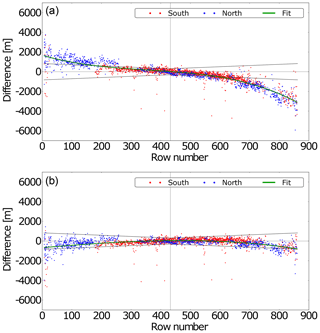
Figure 6(a) Along-track distance between the coastline points determined from TROPOMI (band 6) radiance and the 50 m accuracy PGSD reference versus illuminated detector row number. The land–water orientation of the scenes are labelled by colour, while the black lines indicate the geolocation knowledge requirements, as extended linearly from the nadir to the edge of the swath. Ignoring outliers, at nadir (indicated by a vertical line) the differences lie within the requirement. However, large positive differences for low row numbers and large negative differences for high row numbers are distributed linearly. (b) The same data but now with a yaw-angle correction of 0.002 rad applied in the L1b processor. The differences for low and high row numbers are now mostly within the requirements (black lines) and more symmetrical.
The L1b processor assigns a wavelength to every spectral pixel based on on-ground calibration data. In L2 processing this assignment is used as an initial value for wavelength fitting. After launch it was observed from L2 retrievals that the assignment is shifted with respect to the fitted values. From gravity release and the connected mechanical relaxation some impact on the spectral calibration can be expected. For the SWIR spectrometer, the temperature of the grating plays a big role for the wavelength stability. The wavelength fit results from the algorithms for daily aerosol index (band 3), NO2 (band 4), clouds (band 6) and CO (band 7) were used as input for a CKD update. For other bands no operational data, where only a wavelength shift and no wavelength squeeze is fitted, were available. The wavelength fits showed some variation both in the detectors' spatial direction and over time. For the UVN spectrometers both variations are within the accuracy of the on-ground calibration values of 9 pm. For the SWIR spectrometer, the change over time is much larger than the on-ground accuracy (0.06 pm) and is related to the very long thermalization time of the grating.
The nominal wavelength annotation CKD have been updated with a wavelength shift Δλ based on radiance L2 fitting data. In Table 3 the averaged observed shifts and the implemented correction to the CKD are shown. A single shift per detector is added to the on-ground calibration data but only where the shift exceeds the on-ground calibration accuracy. The value has been chosen from data from the middle of September 2018 for the SWIR spectrometer and at the beginning of October 2018 for the UVN spectrometer. The correction will become active with version 2 of the L1b processor. In case the wavelength calibration changes further or data for other bands become available, the CKD can be updated.
When the slit in the optical path is locally obstructed, the instrument throughput is lowered for specific viewing angles corresponding to detector rows (spatial direction) and the instrument spectral response function (ISRF) can change for these angles. For the UV detector a lower signal was observed for detector rows 335–337 after launch. The other detectors show no signature of a slit irregularity. From the instrument design as shown in Fig. 1 it can be seen that not the main instrument slit but the slit in the UV spectrometer is most likely causing the feature. A slit irregularity correction had already been foreseen in the L1b processor, so only an update of the calibration key data (CKD) was needed. The CKD have been derived from unbinned measurements with the internal white-light source (WLS). The WLS is located inside the calibration unit, and its light reaches the main instrument telescope via the side of either one of the diffusers and the folding mirror mechanism (FMM) as shown in Fig. 1. Unlike radiance or irradiance measurements, the WLS provides a smooth spectrum without spectral lines. The image is corrected for the pixel response non-uniformity (PRNU), normalized with the signal in an unaffected row in the vicinity of the irregularity and then fitted linearly over 25 rows around the irregularity. To improve the fit, the signal is averaged over 5 spectral pixels (columns). The derived correction is the largest in detector row 335 with 6 % and has been determined with a relative error of 1.09 % for band 1 and 0.30 % for band 2. The error is larger in band 1 due to a lower signal-to-noise ratio of the available measurements. Figure 7 shows the irradiance signal in band 2 before and after the correction. The shown measurement type with instrument configuration identifier (ICID) 202 is the one also used for Level 2 processing with the same binning scheme as the nominal radiance measurements. Detector rows 335 and 336 correspond in this example to the binned row counter 144. The slit irregularity is so far stable, both in location and magnitude. The stability and the remaining effects were determined using corrected WLS measurements from different instrument settings and from different orbits during the mission. The validation confirms the uncertainty as derived for the CKD error. The on-board light sources for the UVN spectrometers are not suitable for investigating a possible change in the ISRF for the affected rows. However, most Level 2 algorithms take small changes in the ISRF into account, so the impact is expected to be small. The slit irregularity correction will become active with version 2 of the L1b processor.
The relative angular radiometry of the TROPOMI solar port had been measured during the on-ground calibration campaign. However the measurement suffered from instabilities of the optical stimulus, and as a consequence only key data for one of the two internal quasi volume diffusers (QVD), namely QVD2, could be derived with a reduced angular resolution; see Kleipool et al. (2018). In flight the entire elevation angle range of the solar port is covered during each solar measurement; however the azimuth angle range is only covered over the course of 1 year. To obtain valid key data for the entire solar angle range before the start of nominal operations, the different azimuth angles were obtained by moving the platform with a slew manoeuvre in successive orbits. Both internal solar diffusers QVD1 and QVD2 were recalibrated with a higher sampling of the illumination angles than used on the ground. For QVD1, the main diffuser, 400 consecutive orbits (starting in orbit 1247) were used for the solar calibration; this corresponds to azimuth angles every 0.15∘ between −15 and +15∘ with reference points in between. During on-ground calibration it was not possible to cover the entire azimuth range, and the measurement grid was 10 times coarser than in flight. For the elevation angle the in-flight grid is more than 25 times finer than the on-ground one. For QVD2, the backup diffuser, the sampling was reduced to 0.25∘ over 240 orbits in the same azimuth range and also with references in between. The reduction was chosen due to the observed degradation in QVD1 (see also Sect. 12). The reference points are measured to account for instrument degradation, possible electronic drifts and changes in solar output. The reference angle is 1.269∘ azimuth and 0∘ elevation, the same solar angle as used on the ground for the absolute irradiance calibration. The solar measurements are performed around the northern day–night terminator, where the solar zenith angle is approximately 90∘. During the solar measurements the azimuth angle drifts over a small range (≈1.5∘) around the commanded azimuth angle. The measurement duration is long enough to cover the full elevation range ( to +5∘). From each series of azimuth angles around the reference azimuth angle, the frame closest to the reference angle is chosen as the reference measurement. This frame is then used to determine the relative irradiance and degradation. The overall azimuth grid is sampled such that the full range is scanned several times with a successively finer resolution alternating with reference measurements. This is to ensure the sampling of the entire solar angle range even if not all measurements can be performed or are missing due to downlink issues. Both QVDs were measured without row binning in the illuminated region. The CKD for QVD1 and QVD2 do not differ substantially; therefore only results for QVD1 are shown here.
For the analysis the same fitting approach was chosen as for the on-ground calibration analysis described in Kleipool et al. (2018): all measurements are processed up to and including the Sun-distance correction, divided by the reference frame from the following orbit and transformed to an azimuth–elevation super-pixel grid of size 10 pixels×10 pixels. In Fig. 8 the normalized measurements of such a super pixel (row 20, column 30) are shown for each detector for QVD1. There is a substantial but smooth variation in the azimuth direction of about 15 % between −10 and +10∘.
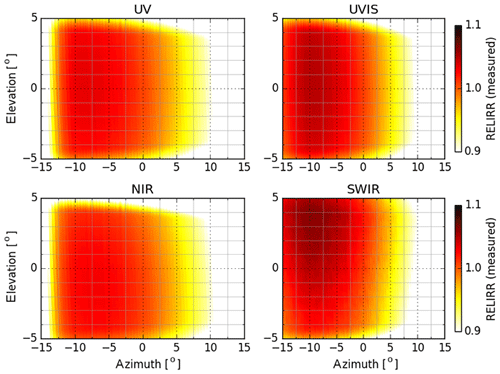
Figure 8The relative irradiance (RELIRR) in-flight measurements for diffuser 1 (QVD1) divided by their reference measurements. Shown are the values for the different solar angles for a super pixel in the detector corner (row 20, column 30) for each detector. The variation in azimuth direction is smooth. For both solar angles the signal cut-off is visible.
In the elevation direction the variation between −4 and +4∘ is small, but the drop in signal for larger deviations is sudden. To derive the relative irradiance key data, a fit is performed on this super-pixel grid using an eighth-order Chebyshev polynomial both in the azimuth and elevation direction. The polynomial was fitted to values between −10 and +10∘ in the azimuth direction and −4 and +4∘ in the elevation direction as shown in Fig. 9. The higher angular sampling shows more detail and is best reflected with a polynomial higher in order than that used for the on-ground data. The fitting window covers the natural yearly solar azimuth variation for the reference orbit with an Equator crossing time of 13:30 local solar time.
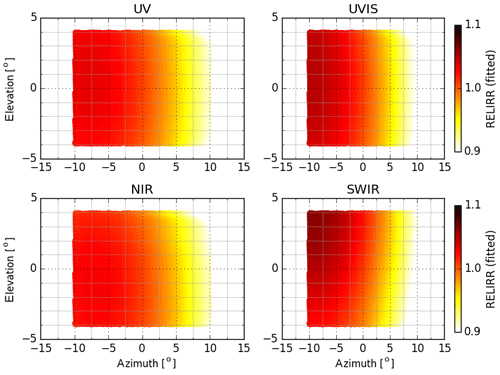
Figure 9The fit for the values in Fig. 8 using an eighth-order Chebyshev polynomial both in the azimuth and elevation direction. The polynomial was fitted to values between −10 and +10∘ in the azimuth direction and −4 and +4∘ in the elevation direction.
The residuals that remain after application of the Chebyshev fit as shown in Fig. 10 are largely caused by the variation between the orbits; see also Sect. 12 for the description of the residuals. Every track along the azimuth–elevation has a distinct amplitude. The origin of this variation is not yet exactly known. This random variation that is around 1– poses a lower bound of the exactness of the fit for the available data. To validate the integration of processor and key data, double processing is performed: data that have already been corrected with the derived CKD are reanalysed for remaining effects. Double-processing irradiance data with the derived relative irradiance CKD reduces the standard deviation to the order of . This result is an order of magnitude better than what was achieved with double processing of the CKD derived from on-ground calibration data.
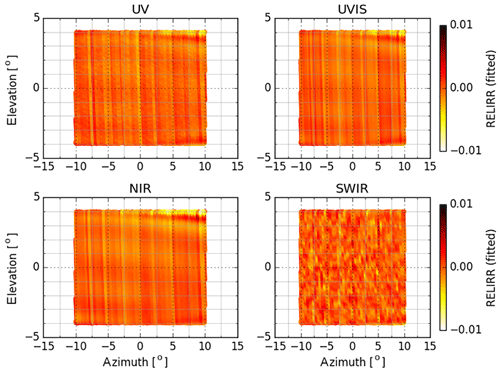
Figure 10The residuals of the fit shown in Fig. 9. Orbit-to-orbit variations (visible as stripes) form the main contribution.
Calibrating the solar diffusers in flight by moving the platform proved to be very successful: apart from the better accuracy, the new CKD also show more detail than the on-ground CKD. In Fig. 11 the CKD from on-ground and in-flight calibration are shown with the difference between them which is up to 2 percentage points. With version 2 of the L1b processor accurate key data for both internal diffusers will be available. The slew manoeuvres are included in the nominal operations baseline as described in Sect. 14. This reduces the measured azimuth range to less than ±1∘ around the reference angle.
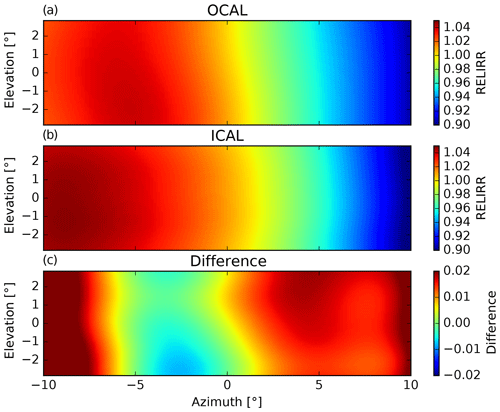
Figure 11The CKD for band 3 for diffuser QVD1 as derived from the on-ground campaign data (a); the CKD derived from commissioning-phase data (b); and the difference between the two (c). Shown is the value for a super pixel in the corner of the detector in row 20 and column 30. The in-flight CKD show more detail, and the in-flight and on-ground CKD differ by up to 2 percentage points.
In flight the instrument is exposed to UV light and cosmic radiation potentially causing degradation of optical and electronic parts. Apart from the degradation, electronic drifts can occur that lower the radiometric accuracy of the radiance and irradiance. During nominal operations calibration and monitoring measurements are scheduled on a regular basis to be able to correct for degradation and drift effects. The TROPOMI instrument is designed such that all optical elements in the Earth view mode are included in the optical path when the Sun is measured. Thereby all degradation occurring in the spectrometers should cancel out when the reflectance is considered. To be able to determine the Earth's reflectance, the instrument measures the Sun via internal quasi volume diffusers (QVDs) on a regular basis. The main diffuser (QVD1) is used every day and once a fortnight and the backup diffuser (QVD2) every week during nominal operation.
Although degradation effects should cancel each other out for the reflectance, this only holds if the solar port degradation is corrected. In addition, it is highly desirable to isolate the degradation of the spectrometers and correct for it separately. In this way irradiance, radiance and reflectance are all stand-alone products.
Thus, the challenge is to separate the various degradation and drift effects and identify where exactly in the instrument they occur. For diagnostics the internal light sources and solar measurements can be used. To determine relative electronic drifts, the DLEDs which are situated close to the detectors are used. The optical path of the WLS includes additional elements which are not part of the optical path for light from the Earth or the Sun, and the WLS light does not pass through the QVDs. The internal light sources also show a decrease in output which cannot be separated from instrument degradation as described in Sect. 4. The internal light sources are therefore less suitable for the calibration of the degradation of the irradiance and radiance optical paths. Radiance measurements in general show much variability in themselves and would require too much input from atmospheric models to be useful for the derivation and regular update of an independent and sufficiently accurate degradation correction for operational L1b processing. In the future the derived correction needs to be validated by – for example – using sites with well-known reflectance.
During the commissioning phase of TROPOMI several effects were identified: the degradation of the diffusers (QVD1 and QVD2) used for irradiance measurements, a drift of the CCD gain for the UVN spectrometers and a gradual spectrally dependent increase in the throughput in the UV spectrometer. This spectral ageing in the UV spectrometer is observed for irradiance, radiance and WLS data and cannot be found in on-ground data. With the exception of the UV spectrometer, so far no degradation could be identified within the other spectrometers. If – in the future – degradation can also be identified for spectrometers other than the UV one, the L1b processor has the capability to correct spectrometer degradation for all bands provided that calibration key data can be derived.
To describe the spectrometer and solar port degradation for both internal diffusers QVD1 and QVD2, a model is used where the different contributions multiply to the total observed signal. For each (illuminated) detector pixel the total degradation Dtot is described by a linear system per QVD:
The total degradation is modelled by a contribution from the specific diffuser Dq1 or Dq2, a contribution which is common for both diffusers Dcom, a contribution which can be attributed specifically to the spectrometer Dspec, and the residuals Rk and Pk. The residuals describe mainly measurement-to-measurement variations; some of them are common to both diffusers (Rk), and some are specific for QVD2 (Pk). The variable k denotes the time in orbit numbers. The specific degradation curves Dq1 and Dq2 are best described by exponential curves, where the decay rate for Dq2 is about 6 times smaller than for Dq1, the ratio of usage between QVD1 and QVD2. The component Dcom denotes an exponential decay which is observed for irradiance measurements both via QVD1 and QVD2 and cannot be explained by the difference in usage. This common degradation could have its cause in the folding mirror, which is part of the irradiance path for both diffusers; in the telescope; or within the spectrometers.
To solve the linear system in Eq. (1), the solar irradiance measurements for QVD1 and QVD2 are collected. Only the frames at the solar reference angle at 1.269∘ azimuth and 0∘ elevation are used. Used are the weekly irradiance measurements for QVD2 and for QVD1 only the ones which are taken on the same day as the QVD2 measurements. The total usage time of the two QVDs tq1(k) and tq2(k) is extracted from the in-flight calibration database and is used to determine the ratio in the degradation rate. After various corrections, such as for electronic gain (and gain drift for the UVN detectors) and Earth–Sun distance, the images for all spectrometers are regridded on their respective wavelength grid to remove the spectral smile. The images are then divided by the reference image (orbit 2818 for QVD1 and orbit 2819 for QVD2) and regridded onto a coarser grid of super pixels to reduce noise. For the UVN (SWIR) measurements a super-pixel stretches over 20 (12) rows in the spatial direction. In the spectral direction (columns) it is 5, 10, 20 and 20 pixels for the UV, UVIS, NIR and SWIR spectral ranges respectively. Apart from the spectrometer degradation in the UV spectrometer, the data are spatially and spectrally smooth, so the super-pixel size has no impact on the result apart from noise reduction. For each of these super pixels the linear system in Eq. (1) is solved. For the UVIS, NIR and SWIR spectrometers no spectrometer degradation Dspec could be determined, and this term is therefore set to unity. Following the postulate of the model, all three solutions for Dq1, Dq2 and Dcom are exponential decay functions and perfectly smooth in the temporal dimension. All temporal measurement-to-measurement variation is contained in the residual images Rk and Pk. If the residuals show in the future that the assumption of exponential decay is not justified anymore, a different fitting function can be used.
The UV spectrometer has a spectral overlap with the UVIS spectrometer in the range of 312–330 nm. In this spectral range the degradation should be identical for the UV and UVIS spectral range if the degradation occurs within the optical path they have in common, i.e. diffusers, folding mirror and telescope. By extrapolating the common degradation Dcom derived for the UVIS spectral range into the UV spectral range, the spectrometer-specific degradation Dspec for the UV spectrometer can be isolated. Figure 12a shows the resulting modelled UV spectrometer degradation and the actual measured signal ratios. In Fig. 12b it can be seen that the ratio of signals as measured by the UV and UVIS spectrometers at 317 nm evolves smoothly once the residual temporal variations (Rk and Pk) are removed.

Figure 12(a) Spectral degradation in the UV spectrometer from measured irradiance ratios between band 2 and band 3 (blue) and Dspec as computed from the model (green) for orbit 8849. The other model contributions are not included here. (b) Evolution of the ratio of measured signals at 317 nm, with (green) and without (blue) correction of the temporal variation ratios. Note the constant rate of increase of 1 % per 1000 orbits.
By using spatial and spectral filtering and some averaging in time, the solutions for Dq1, Dq2, Dcom and Dspec are turned into unbinned calibration key data for each spectrometer and QVD.
Figures 13–15 show for each UVN spectrometer irradiance signals from several orbits before and after correction with the new degradation key data. For the latest orbit the correction is based on extrapolation within the L1b processor. In this example the extrapolation is over about 3.5 months. The residuals after correction are smaller than 0.1 %. The degradation is highest for short wavelengths in the UV (Fig. 13) and UVIS (Fig. 14) spectral ranges, low in the NIR spectral range (Fig. 15), and negligible for the SWIR spectral range as visible in Fig. 16.

Figure 13Row-averaged irradiance signal of the UV detector via QVD1 for orbits 2818 (flat black line), 4348 (green), 5878 (red) and 7318 (cyan). The plot (a) is without degradation correction and clearly shows the spectral dependence of the degradation and the increase in signal for some spectral ranges. The plot (b) shows the corrected signal where the degradation CKD used only the measurements up to and including orbit 5878. The latest orbit in the plot (cyan) is corrected using extrapolation in the L1b processor.
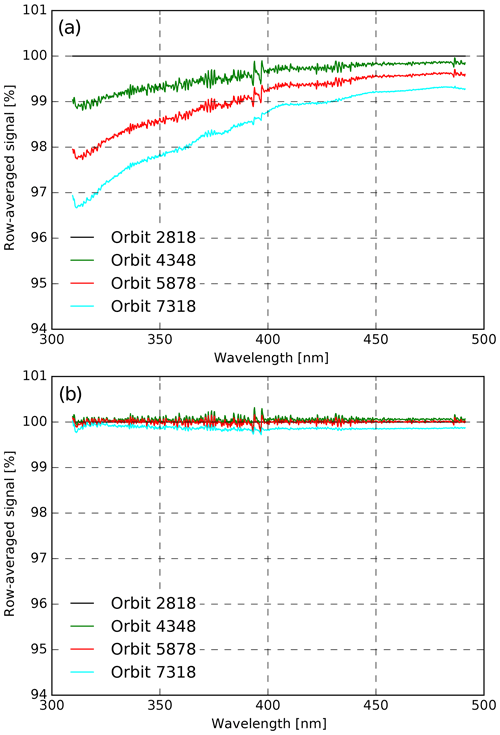
Figure 14Row-averaged irradiance signal of the UVIS detector via QVD1 for orbits 2818 (flat black line), 4348 (green), 5878 (red) and 7318 (cyan). The plot (a) is without degradation correction and clearly shows the spectral dependence of the degradation but no increase in signal unlike the UV detector in Fig. 13. The plot (b) shows the corrected signal where the degradation CKD used only the measurements up to and including orbit 5878. The latest orbit in the plot (cyan) is corrected using extrapolation in the L1b processor.
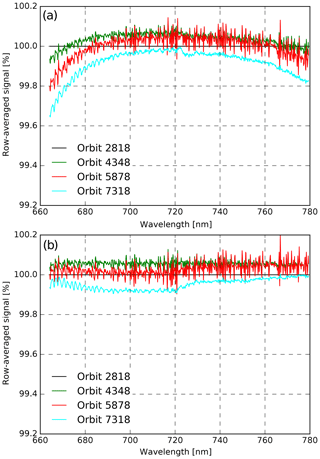
Figure 15Row-averaged irradiance signal of the NIR detector via QVD1 for orbits 2818 (flat black line), 4348 (green), 5878 (red) and 7318 (cyan). Plot (a) is without degradation correction and shows much less degradation than in the UV and UVIS spectral ranges. Plot (b) shows the corrected signal where the degradation CKD used only the measurements up to and including orbit 5878. The latest orbit in the plot (cyan) is corrected using extrapolation in the L1b processor.

Figure 16Normalized irradiance measurements for the SWIR detector for QVD1 (a) and QVD2 (b) over time. Signals are shown as row averages versus wavelength. Shown are orbits 2818 and 2819 (black flat line), 4348 and 4349 (green), 5878 and 5879 (red), and 7318 and 7319 (cyan). The spread of signal values for the different orbits shows neither a trend nor a wavelength dependence.
In the UV spectrometer, the spectrometer-specific degradation Dspec shows a characteristic spectral signature where the signal increases over time. In Fig. 13a it can be seen that this spectrometer ageing is stronger than the signal decrease due to the diffuser degradation. In this way the UV spectrometer ageing nullifies the diffuser degradation. Irradiance measurements with the UVIS spectrometer in Fig. 14 show a clear spectral dependence but no increase in signal with time. For the NIR spectrometer (Fig. 15) the measurement-to-measurement variations are larger than the degradation. Figure 16 shows that no wavelength dependence of the degradation can be detected for the SWIR spectrometer. This is not unexpected considering the small wavelength range covered (90 nm) and the absolute wavelength scale (2400 nm). The observed change in irradiance signal shows measurement-to-measurement variations; in the model in Eq. (1) these are the residuals Rk and Pk, and they are shown in Fig. 17. These temporal variations are spectrally and spatially smooth for each spectrometer and nondeterministic. There is a close correlation between the temporal variations in the UVIS and NIR spectrometers and the variations observed with the UV and SWIR spectrometers. The two pairs are not correlated and the UV–SWIR variations have about half the magnitude of the UVIS–NIR variations. The residuals are not corrected in the L1b processor. In the UV, UVIS and NIR spectrometers the derived degradation key data have the same character; only the quantities differ. For the SWIR spectrometer the spread of signal values from measurement to measurement is large compared to the average change over time; this can be clearly seen in Fig. 18. The signal spread in the SWIR spectrometer seems to be dominated by electronic noise and not by irradiance measurement variations. The observed degradation in the SWIR spectrometer is qualitatively not similar to the UVN degradation. Neutral degradation CKD will therefore be used for the SWIR spectrometer.
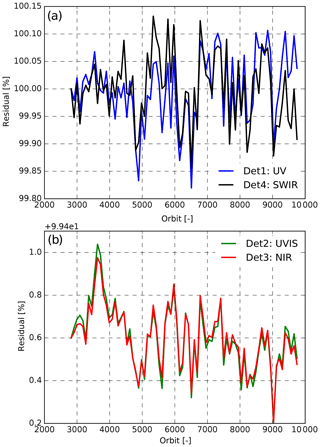
Figure 17The residual temporal variation components Rk of the irradiance measurements as modelled in Eq. (1) over time. The residuals have been computed independently for all spectrometers, and the similarity is not imposed by the model. (a) UV (blue) and SWIR (black) spectrometers. The magnitude is notably smaller than for the UVIS (green) and NIR (red) spectrometers in (b).

Figure 18Normalized irradiance measurements for the SWIR detector for QVD1 (a) and QVD2 (b). Signals are shown as row averages for three columns. The spread of signal values is large compared to the average change over time.
As a baseline for L1b processing the diffuser degradation is defined relative to the start of the E2 phase; this is orbit 2818 for QVD1 and orbit 2819 for QVD2. The corrections to the absolute irradiance calibration as described in Sect. 13 are tied to the same orbits; in this way all corrections are consistent. The spectrometer-specific degradation Dspec in the UV spectrometer is derived for the entire mission so far, and the correction is applied to both the radiance and irradiance. The correction is also applied to the reference orbits for the absolute irradiance calibration. As degradation continues with time, the calibration key data will need regular updates to ensure that the accuracy is not lowered due to extrapolation of the key data in the L1b processor and that the steps occurring in the data around updates are minimal. In Table 4 the degradation per 1000 orbits is shown per band and for the different contributions. For the UV spectral degradation at 317 nm the increase in signal amounts to almost 1 % per 1000 orbits.
Table 4The mean degradation per 1000 orbits as determined up to orbit 9748. Shown is the modelled degradation of the QVD1 (Dq1) and the QVD2 (Dq2), together with their common degradation Dcom. Moreover, in the UV spectrometer a spectral ageing component Dspec of up to 1 % per 1000 orbits reverses the apparent degradation. The maximum and standard deviation of the residuals max(Rk) and σ(Rk) observed with the UV (and SWIR) spectrometer are consistently lower than those observed with the UVIS and NIR spectrometers. The modelled degradation for the NIR and SWIR spectral ranges is on the order of the maximum residual value. The values for the SWIR spectral range have not been implemented in an L1b correction.

The absolute irradiance calibration aims to ensure that the sensitivity of the TROPOMI instrument for each measured wavelength (i.e. at each detector pixel) is adjusted such that the measured irradiance reflects the solar output per wavelength. This was carried out during the on-ground calibration campaign (OCAL), but there were several issues with the stimuli as reported in Kleipool et al. (2018). Especially in bands 1–3 the calibration measurements were affected by a low signal-to-noise ratio. In-flight measurements revealed that the absolute irradiance calibration for the UV and UVIS spectrometers is inconsistent. Band 2 of the UV spectrometer and band 3 of the UVIS spectrometer have some spectral overlap, and correctly calibrated data should give the same irradiance values for both bands in this wavelength range. As can be seen in Fig. 20 from the uncorrected data, this is not the case. With only the on-ground calibration applied, the irradiance in the UV spectrometer is visibly lower than that of other instruments and there is a discontinuity between the UV (270–330 nm) and UVIS (310–500 nm) spectrometers in their overlap region. An investigation of various on-ground illumination sources via the Sun and the Earth port showed that the discontinuity is exclusively observed for the absolute irradiance calibration with the FEL lamp. The absolute radiance calibration with the FEL lamp is consistent with other calibration sources. To remove this inconsistency for the UV and UVIS spectrometers, the solar spectrum of TROPOMI is compared to different published solar reference datasets as shown in Fig. 19. The correction to the absolute irradiance is derived for orbits 2818 (QVD1) and 2819 (QVD2), the same orbits the diffuser degradation is tied to. The UV-spectrometer-specific degradation has been corrected in the used data; see Sect. 12.
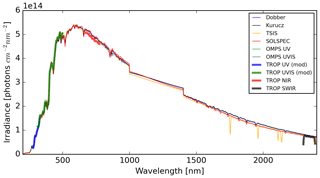
Figure 19The solar spectrum according to reference spectra (thin lines) such as Dobber (red), Kurucz (black), TSIS (orange), SOLSPEC (red), and OMPS (green) and the four TROPOMI spectrometers via diffuser QVD1 (thick lines) in orbit 2818. The TROPOMI UV and UVIS spectra are modified as described in the text. All spectra were convoluted with a Gaussian kernel with a 3.0 nm standard deviation on the Dobber grid.
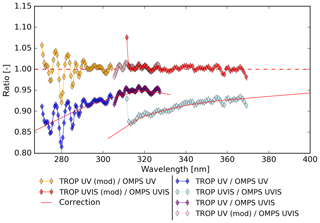
Figure 20The TROPOMI UV and UVIS spectra via QVD1 (blue, purple and light blue), divided by the OMPS spectrum. The ratio differs between bands 2 (purple) and 3 (light blue) in the spectral overlap region of TROPOMI. In orange, pink and red the modified spectra are shown. They were modified with the cubic splines as indicated by the red lines. All spectra are convolved with a 1.0 nm Gaussian kernel.
Well-known solar references are the high-resolution Dobber spectrum (±0.014 nm per pixel; Dobber et al., 2008) and the Kurucz spectrum (Chance and Kurucz, 2010), which cover the spectral range of the TROPOMI instrument. They are both high-resolution composites of different solar measurement campaigns and not based on a single instrument. Other datasets are from the Total and Spectral Solar Irradiance Sensor (TSIS) instrument on board the International Space Station (LASP Interactive Solar Irradiance Datacenter, 2019) and the Spectral Irradiance Montior (SIM) (Woods et al., 2009) and SOlar SPECtrometer (SOLSPEC) (Thuillier et al., 2003) data. The SIM spectrum was once corrected (Woods et al., 2009) with a bias to be in closer agreement to the Dobber (Dobber et al., 2008) and Thuillier SOLSPEC spectra (Thuillier et al., 2003), but more recently the spectrum has been published in its original, uncorrected state (Harder et al., 2010), showing much more resemblance to the SOLSPEC spectrum published by Meftah et al. (2018) and the TROPOMI spectrum. Other instruments that measure solar spectra in the TROPOMI UV and UVIS spectral range are the Ozone Monitoring Instrument (OMI) and the Ozone Mapping and Profiler Suite (OMPS). The former has been calibrated using the Dobber spectrum. To reduce possible interdependencies by using a composite spectrum, we have chosen to use the OMPS solar irradiance spectrum (Jaross et al., 2014; Seftor et al., 2014; NASA Goddard Space Flight Center, 2019) as a reference level for the absolute calibration of the TROPOMI irradiance spectrum in the spectral range of bands 1–3. The OMPS instrument has very similar spectral characteristics to TROPOMI, and the published spectrum is solely based on OMPS data. The difference between the TROPOMI and OMPS spectrum can be largely resolved by multiplying the TROPOMI spectrum with a (piecewise) linear function.
The on-ground radiometric calibration for the TROPOMI instrument was performed using an FEL lamp, which has a spectrally smooth output, suggesting that the calibration did not introduce spectral features. Speckle introduced by the internal diffusers was filtered as described in Kleipool et al. (2018). Therefore, any adjustment of the absolute calibration should also be spectrally smooth. Each spectrum is convolved with a Gaussian kernel, with a standard deviation that is representative of the effective spectral resolution of the instrument or larger.
The TROPOMI solar spectral irradiance for the UV and UVIS spectrometers is adjusted by finding piecewise linear approximations of the ratio of TROPOMI and OMPS and joining them with a cubic spline. The initial ratio and the corrected ratio together with the used cubic spline are shown in Fig. 20 for UV and the UVIS band 3. Band 4 of the UVIS spectrometer is outside the spectral range of OMPS. In Fig. 21 all the corrected UV and UVIS bands are shown relative to reference data. For validation and clarity, the data shown are convolved with a kernel with standard deviation of 1 nm, while the fit of the cubic splines used for the correction is based on convolutions with a kernel with standard deviation of 3 nm to reduce the impact of spectral lines. It can be seen that the spectra of the UV and UVIS spectrometers have been modified by at least 5 % and at most 15 %. The gap between the UV and UVIS spectrometers in the spectral overlap region has disappeared. For wavelengths above 450 nm the correction is a bias, bringing the data into good agreement with SOLSPEC and TSIS. All the shown data are for diffuser QVD1, but the correction was derived for both diffusers and is very similar.
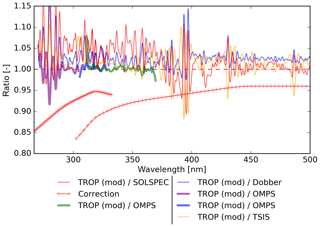
Figure 21The ratio of the corrected spectrum via QVD1 in orbit 2818 with respect to the various reference spectra, convolved with a σ=1.0 nm Gaussian kernel. The thick purple, blue and green lines indicate the ratio with OMPS data which the correction is based on. The correction splines (red crosses) bring the TROPOMI spectrum into good general agreement with several reference spectra. The spectrum shows similarity to the other spectra on a larger scale, except for a bias on the order of 0 %–5 %.
For the NIR and SWIR spectrometers the deviations from the reference spectra are much smaller than for the UV spectrometer and also seem to consist mainly of a spectrally flat bias. As shown in Fig. 22 the spectrum of the NIR spectrometer is approximately 1.5 %–3.5 % lower than the reference spectra. The SWIR spectrum shown in Fig. 23 is approximately 1.5 %–7 % lower than the reference spectra, but it is closest to the SOLSPEC spectrum published by Meftah et al. (2018), which resembles the SIM spectrum in its uncorrected state (Harder et al., 2010; not shown). Considering the spread of the reference spectra and the uncertainty in the TROPOMI on-ground calibration of around 1 % it seems unwise to change the TROPOMI NIR and SWIR solar spectra to match any of the other references. Therefore no modifications of the irradiance on-ground calibration were performed for the NIR and SWIR spectrometers and their calibration remains independent from other instruments and references. Adapting only the irradiance calibration for the UV and UVIS spectrometers changes the reflectance for these spectral ranges. Initial validation tests show that this has indeed a positive impact on the L2 retrievals. In the future a more extensive reassessment of the radiometric accuracy can be performed and any potentially remaining inconsistencies in radiance and irradiance can be addressed.
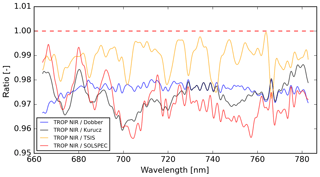
Figure 22The ratio of the NIR spectrum via QVD1 in orbit 2818 with respect to the Dobber (blue), Kurucz (green), TSIS (orange) and SOLSPEC (red) spectra. All NIR spectra are convolved with a σ=1.0 nm Gaussian kernel.
Several of the findings from the commissioning phase resulted in changes to the planned nominal operations baseline. An overview of the nominal operations baseline can be found in KNMI (2017). The main change is that the matching background measurements for the radiance measurements are performed with a closed folding mirror (FMM) to ensure that remaining light from the eclipse side of the Earth is blocked off. The FMM is a life-limited item, so this is only performed in orbits where the FMM is employed anyway to perform calibration measurements. The different orbit types were rearranged such that the radiance background is measured 6–7 times per day. All calibration and background measurements are scheduled in full eclipse times only. As a consequence some calibration measurements are occasionally performed inside the South Atlantic Anomaly (SAA) and flagged as such. Another substantial change is that the irradiance measurements are performed close to the solar azimuth angle where the absolute calibration has been performed. To achieve this, the platform performs a slew manoeuvre with the on-board reaction wheels before the irradiance measurements are made as performed for the relative irradiance calibration described in Sect. 11. This reduces the angle range over which the relative irradiance correction needs to be applied and prepares for the possibility that the solar angle moves outside the design range, which can happen if – for example at the end of the mission lifetime – the orbit is changed.
The radiance signals vary over latitude during each orbit. During the commissioning phase the instrument settings for the different signal levels were fine-tuned for optimal signal while minimizing saturation. Small changes were also applied to instrument settings to measure irradiance and the internal light sources. All insights from the commissioning phase were already included in an updated nominal operations scenario before the start of the nominal operations (E2) phase in orbit 2818 on 30 April 2018.
The only change in nominal operations after the start of the E2 phase was the reduction in the radiance co-addition time from 1080 to 840 ms starting in orbit 9388 on 6 August 2019. This results in a shorter minimal along-track sampling distance: before it was approximately 7 km at nadir, and it is now about 5.5 km. In the across-track direction the minimal sampling distance at nadir is around 3.5 km for bands 2–6, about 7 km for bands 7–8 and around 28 km for band 1. The lower limits for the bands are due to different row-binning values for the UVN (bands 1–6) spectrometers and the spectrometer's instantaneous field of view (SWIR, bands 7–8).
The TROPOMI instrument on-board the Sentinel-5 Precursor satellite is functioning very well. The thermal and orbital stability is very good. Only during orbital manoeuvres can instrument temperatures increase, impacting mainly the spectral calibration of the SWIR spectrometer. Thermal instabilities will be flagged in the updated L1b processor. The internal light sources WLS, CLED and DLED show a continuous decrease in output of at most 0.9 % per 1000 orbits. The CCD output gain of the UVN detectors displays drifts. Based on regularly performed calibration measurements with internal sources, these drifts can be corrected to within better than 0.1 %. High signals can lead to pixel saturation and charge blooming for the UVN detectors. This occurs mainly in bands 4 and 6. Version 2 of the L1b processor includes a new algorithm where affected pixels are flagged. The validation of the geolocation showed that an additional yaw-angle correction of 0.002 rad was needed to allow for changes due to gravity release after launch. This correction had already been implemented in version 1 of the L1b processor and has been active since the beginning of the nominal operations phase. Small corrections were also derived for the spectral annotation of the UVIS and SWIR spectrometers. In the UV spectrometer a slit irregularity was observed after launch. The drop in signal for several rows is corrected in the processor update.
The calibration of the solar angle dependence of the irradiance radiometry, which was too inaccurate on the ground, was successfully performed in flight by moving the platform to cover the different angles. The resulting key data have a higher sampling and a higher accuracy than what was previously available.
In flight, several degradation effects have been observed; they are strongest in the UV spectral range and can be isolated and modelled. They will be corrected with version 2 of the L1b processor using time-dependent calibration key data. Calibration key data for instrument properties which change over time, such as the diffuser degradation or the UVN gain drift, now have a time axis. The updated processor is also able to handle possible future degradation effects for both irradiance and radiance data; the algorithms are in place for all detectors.
During in-flight commissioning some inconsistencies in the on-ground calibration results were found and corrections were developed. This concerns mainly the absolute irradiance radiometric calibration. From comparison with several reference solar irradiance spectra, a spectrally smooth correction was applied to the calibration of the UV and UVIS spectrometers.
Version 2 of the L1b processor, with all updated and new key data presented in this paper, is planned to be in operation from late 2020 on.
The plots and analysis presented in this article contain modified Copernicus Sentinel-5 Precursor data (2017–2019). The S5P user products are available via the Sentinel-5P Pre-Operations Data Hub (ESA, 2020). In-flight monitoring and calibration data can be found via the TROPOMI Science Website (KNMI, 2020).
RB performed data analysis and investigated the degradation in the UV spectrometer. QK is the instrument scientist and project lead of the L1b data processing and calibration development. RL was in charge of the data-processing chain and developed the transient flagging algorithm. JL developed all geometric calibration analysis software and is responsible for the geolocation annotation in the L1b data processor. AL is the optical expert and planned the in-flight commissioning and calibration activities and programmed the instrument settings. EL is the mathematical consultant and was responsible for all algorithm definitions, and he analysed and reported on most electronic calibrations and developed the degradation corrections. PM was responsible for all database engineering required for the calibration processing. EvdP derived the relative radiometric response of the irradiance, which also included the detectors' PRNU, and corrections to the absolute irradiance. NR is the system architect and acting lead of the L1b data-processing development team, and he developed the blooming correction. FV was the system engineer for the overall software development and responsible for the release management. PV is acting principal investigator for the TROPOMI payload on-board the Sentinel-5 Precursor satellite.
The authors declare that they have no conflict of interest.
This article is part of the special issue “TROPOMI on Sentinel-5 Precursor: first year in operation (AMT/ACP inter-journal SI)”. It is not associated with a conference.
The authors wish to thank Eduardo Zornoza and the ESOC flight operations team, the S5P commissioning manager Sten Ekholm (ESTEC), and Mirna van Hoek and Jacques Claas of the KNMI instrument operations team. We also would like to thank the referees for their valuable review of the paper.
This work was funded by the Netherlands Space Office (NSO), under the TROPOMI science contract.
This paper was edited by Mark Weber and reviewed by Ruediger Lang and two anonymous referees.
Bovensmann, H., Burrows, J. P., Buchwitz, M., Frerick, J., Noël, S., Rozanov, V. V., Chance, K. V., and Goede, A. P. H.: SCIAMACHY: Mission Objectives and Measurement Modes, J. Atmos. Sci., 56, 127–150, https://doi.org/10.1175/1520-0469(1999)056<0127:SMOAMM>2.0.CO;2, 1999. a
Chance, K. and Kurucz, R.: An improved high-resolution solar reference spectrum for Earth's atmosphere measurements in the ultraviolet, visible, and near infrared, J. Quant. Spectrosc. Ra., 111, 1289–1295, https://doi.org/10.1016/j.jqsrt.2010.01.036, 2010. a
Dobber, M., Voors, R., Dirksen, R., Kleipool, Q., and Levelt, P.: The High-Resolution Solar Reference Spectrum between 250 and 550 nm and its Application to Measurements with the Ozone Monitoring Instrument, Sol. Phys., 249, 281–291, https://doi.org/10.1007/s11207-008-9187-7, 2008. a, b
ESA: Sentinel-5P Pre-Operations Data Hub, available at: https://s5phub.copernicus.eu/dhus/#/home, last access: 18 June 2020. a
Harder, J., Thuillier, G., Richard, E., Brown, S., Lykke, K., Snow, M., McClintock, W., Fontenla, J., Woods, T., and Pilewskie, P.: The SORCE SIM Solar Spectrum: Comparison with Recent Observations, Sol. Phys., 263, 3–24, https://doi.org/10.1007/s11207-010-9555-y, 2010. a, b
Ingmann, P., Veihelmann, B., Langen, J., Lamarre, D., Stark, H., and Courrèges-Lacoste, G. B.: Requirements for the GMES Atmosphere Service and ESA's implementation concept: Sentinels-4/-5 and -5p, Remote Sens. Environ., 120, 58–69, https://doi.org/10.1016/j.rse.2012.01.023, 2012. a
Jaross, G., Bhartia, P., Chen, G., Kowitt, M., Haken, M., Chen, Z., Xu, P., Warner, J., and Kelly, T.: OMPS Limb Profiler instrument performance assessment, J. Geophys. Res.-Atmos., 119, 4399–4412, https://doi.org/10.1002/2013JD020482, 2014. a
Kleipool, Q., Ludewig, A., Babić, L., Bartstra, R., Braak, R., Dierssen, W., Dewitte, P.-J., Kenter, P., Landzaat, R., Leloux, J., Loots, E., Meijering, P., van der Plas, E., Rozemeijer, N., Schepers, D., Schiavini, D., Smeets, J., Vacanti, G., Vonk, F., and Veefkind, P.: Pre-launch calibration results of the TROPOMI payload on-board the Sentinel-5 Precursor satellite, Atmos. Meas. Tech., 11, 6439–6479, https://doi.org/10.5194/amt-11-6439-2018, 2018. a, b, c, d, e, f, g, h, i
KNMI: Algorithm theoretical basis document for the TROPOMI L01b data processor, S5P-KNMI-L01B-0009-SD Issue 8.0.0, Royal Netherlands Meteorological Institute (KNMI), available at: http://www.tropomi.eu/document/tropomi-l01b-atbd (last access: 18 June 2020), 2017. a, b, c
KNMI: TROPOMI data products: Level 1, available at: http://www.tropomi.eu/data-products/level-1, last access: 18 June 2020. a
LASP Interactive Solar Irradiance Datacenter: TSIS Solar Spectral Irradiance – Daily Average, Time Series, available at: http://lasp.colorado.edu/lisird/data/tsis_ssi_24hr/ (last access: 18 June 2020), 2019. a
Levelt, P. F., van den Oord, G. H., Dobber, M. R., Malkki, A., Visser, H., de Vries, J., Stammes, P., Lundell, J. O., and Saari, H.: The ozone monitoring instrument, IEEE T. Geosci. Remote, 44, 1093–1101, https://doi.org/10.1109/TGRS.2006.872333, 2006. a
Meftah, M., Damé, L., Bolsée, D., Hauchecorne, A., Pereira, N., Sluse, D., Cessateur, G., Irbah, A., Bureau, J., Weber, M., Bramstedt, K., Hilbig, T., Thiéblemont, R., Marchand, M., Lefèvre, F., Sarkissian, A., and Bekki, S.: SOLAR-ISS: A new reference spectrum based on SOLAR/SOLSPEC observations, Astron. Astrophys., 611, A1, https://doi.org/10.1051/0004-6361/201731316, 2018. a, b
Munro, R., Lang, R., Klaes, D., Poli, G., Retscher, C., Lindstrot, R., Huckle, R., Lacan, A., Grzegorski, M., Holdak, A., Kokhanovsky, A., Livschitz, J., and Eisinger, M.: The GOME-2 instrument on the Metop series of satellites: instrument design, calibration, and level 1 data processing – an overview, Atmos. Meas. Tech., 9, 1279–1301, https://doi.org/10.5194/amt-9-1279-2016, 2016. a
NASA Goddard Space Flight Center: OMPS Ozone Mapping & Profiler Suite, available at: https://ozoneaq.gsfc.nasa.gov/data/omps/ (last access: 18 June 2020), 2019. a
NOAA: Prototype Global Shoreline Data, available at: https://shoreline.noaa.gov/data/datasheets/pgs.html (last access: 18 June 2020), 2016a. a
NOAA: World Vector Shorelines, available at: https://shoreline.noaa.gov/data/datasheets/wvs.html (last access: 18 June 2020), 2016b. a
Seftor, C. J., Jaross, G., Kowitt, M., Haken, M., Li, J., and Flynn, L. E.: Postlaunch performance of the Suomi National Polar-orbiting Partnership Ozone Mapping and Profiler Suite (OMPS) nadir sensors, J. Geophys. Res.-Atmos., 119, 4413–4428, https://doi.org/10.1002/2013JD020472, 2014. a
Thuillier, G., Hersé, M., Labs, D., Foujols, T., Peetermans, W., Gillotay, D., Simon, P., and Mandel, H.: The Solar Spectral Irradiance from 200 to 2400 nm as Measured by the SOLSPEC Spectrometer from the Atlas and Eureca Missions, Sol. Phys., 214, 1–22, https://doi.org/10.1023/A:1024048429145, 2003. a, b
van Kempen, T. A., van Hees, R. M., Tol, P. J. J., Aben, I., and Hoogeveen, R. W. M.: In-flight calibration and monitoring of the Tropospheric Monitoring Instrument (TROPOMI) short-wave infrared (SWIR) module, Atmos. Meas. Tech., 12, 6827–6844, https://doi.org/10.5194/amt-12-6827-2019, 2019. a, b, c
Veefkind, J., Aben, I., McMullan, K., Förster, H., de Vries, J., Otter, G., Claas, J., Eskes, H., de Haan, J., Kleipool, Q., van Weele, M., Hasekamp, O., Hoogeveen, R., Landgraf, J., Snel, R., Tol, P., Ingmann, P., Voors, R., Kruizinga, B., Vink, R., Visser, H., and Levelt, P.: TROPOMI on the ESA Sentinel-5 Precursor: A GMES mission for global observations of the atmospheric composition for climate, air quality and ozone layer applications, Remote Sens. Environ., 120, 70–83, https://doi.org/10.1016/j.rse.2011.09.027, 2012. a
Woods, T., Chamberlin, P., Harder, J., Hock, R., Snow, M., Eparvier, F., Fontenla, J., McClintock, W., and Richard, E.: Solar Irradiance Reference Spectra (SIRS) for the 2008 Whole Heliosphere Interval (WHI), Geophys. Res. Lett., 36, L01101, https://doi.org/10.1029/2008GL036373, 2009. a, b
- Abstract
- Introduction
- Thermal stability
- Light tightness
- Internal sources
- Orbital electronic stability
- Gain drift UVN detectors
- Pixel saturation and charge blooming
- Geolocation
- Spectral annotation
- Slit irregularity
- Relative irradiance calibration
- Absolute radiometry and instrument degradation
- Absolute irradiance calibration
- Changes to the nominal operations baseline
- Conclusions
- Data availability
- Author contributions
- Competing interests
- Special issue statement
- Acknowledgements
- Financial support
- Review statement
- References
- Abstract
- Introduction
- Thermal stability
- Light tightness
- Internal sources
- Orbital electronic stability
- Gain drift UVN detectors
- Pixel saturation and charge blooming
- Geolocation
- Spectral annotation
- Slit irregularity
- Relative irradiance calibration
- Absolute radiometry and instrument degradation
- Absolute irradiance calibration
- Changes to the nominal operations baseline
- Conclusions
- Data availability
- Author contributions
- Competing interests
- Special issue statement
- Acknowledgements
- Financial support
- Review statement
- References









